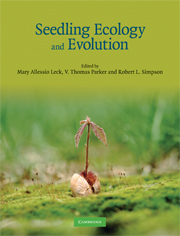Book contents
- Frontmatter
- Contents
- Contributors
- Foreword by Peter J. Grubb
- Preface
- Acknowledgments
- Part I Introduction
- Part II Seedling diversity
- Chapter 2 Seedling natural history
- Chapter 3 Specialized seedling strategies I: seedlings in stressful environments
- Chapter 4 Specialized seedling strategies II: orchids, bromeliads, carnivorous plants, and parasites
- Part III Seedling morphology, evolution, and physiology
- Part IV Life history implications
- Part V Applications
- Part VI Synthesis
- References
- Index
Chapter 2 - Seedling natural history
Published online by Cambridge University Press: 05 June 2012
- Frontmatter
- Contents
- Contributors
- Foreword by Peter J. Grubb
- Preface
- Acknowledgments
- Part I Introduction
- Part II Seedling diversity
- Chapter 2 Seedling natural history
- Chapter 3 Specialized seedling strategies I: seedlings in stressful environments
- Chapter 4 Specialized seedling strategies II: orchids, bromeliads, carnivorous plants, and parasites
- Part III Seedling morphology, evolution, and physiology
- Part IV Life history implications
- Part V Applications
- Part VI Synthesis
- References
- Index
Summary
Introduction
Consider the following: tidal freshwater marshes along the East Coast of North America in springtime; the deserts near Death Valley, in Africa, and elsewhere following a substantial rainfall; the intermittent wetlands in the arid Australian landscape; and the wheat fields of Europe, North America, and New Zealand. Each landscape is awash with the greens of newly emerged seedlings, each species responding to its particular set of germination cues, each informed by its peculiar evolutionary history. Anyone interested in seed banks and seed germination ecology and physiology, as well as those who garden, are intimately familiar with seedlings. Seedlings are also well known to those who produce seeds for use in agriculture and horticulture and who are concerned with vigor and other seedling attributes (Geneve, 2005; Stephenson & Mari, 2005; Farooq et al., 2006). In this chapter, we explore the diverse and fascinating array of seedlings and seedling natural history. Topics include the seedling stage, morphological and physiological diversity, vivipary, seedling equivalents, seedling longevity and dispersal, and environmental filters and safe sites.
Nomenclature generally follows that of the author and family names (Mabberly, 1997).
The seedling stage and fate of seedlings
Contrary to what seems intuitive, the seedling stage is not always easily defined. The success of seedlings is, furthermore, influenced by many environmental factors that determine survival, establishment, and, ultimately, community composition.
The seedling
Seedling is used for a very young individual (Burger, 1972), but problems occur in determining the beginning and end of the stage.
- Type
- Chapter
- Information
- Seedling Ecology and Evolution , pp. 17 - 55Publisher: Cambridge University PressPrint publication year: 2008
- 9
- Cited by



